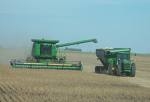Published January 29, 2010 06:33 AM
El Nino to boost 2010 U.S. crops

U.S. farmers grew record-large corn and soy crops in 2009 but
production in 2010 could be even bigger, aided by an El Nino weather
pattern that is typically a boon to the Midwest but less so for growers
in Australia and southeast Asia, a forecaster said on Thursday.
Allen Motew, meteorologist at QT Weather, forecast a dry U.S. spring,
which should minimize problems at planting time, followed by a favorably
wet summer growing season.
"It's exactly what we need to increase (crop) yields," Motew said at the
Top Producer Seminar, a farmers' conference held in Chicago.
Temperatures in the U.S. Corn Belt are expected to be mostly below
normal this summer, while precipitation will be above normal.
"We have a double-whammy here -- colder and wetter," Motew said. "The
odds say we are going to have quite a good year."
Motew said corn yields typically increase when an El Nino weather
pattern persists for two years in a row. The same is likely true for
soybeans, he said.
In two of the most recent such years, 1992 and 1998, corn yields
increased by 21.1 and 6.1 percent, respectively, Motew said.
He said that yields increased during the last 16 of 22 seasons of El
Nino weather.
The average U.S. corn yield in 2009 reached a record 165.2 bushels
per acre, resulting in a record-large crop of 13.2 billion bushels. The
average U.S. soybean yield was also the highest on record, at 44.0
bushels per acre, and production topped 3.3 billion bushels.
El Nino, the abnormal warming of waters in the equatorial Pacific, was
observed in May 2009 and the existing pattern may run until at least
June 2010, the National Weather Service said a week ago.
While El Nino may be beneficial for farmers in the Midwest, the weather
pattern can cause erratic and harsh weather elsewhere in the world.
Motew said El Nino could cause drought conditions during the latter
months of 2009, stressing the palm oil crop in Malaysia and the wheat
crop in Australia.
El Nino has already contributed to bizarre weather in the United States,
including flooding and tornadoes in California and heavy snows in
Oklahoma.
Temperatures have also been above normal in the typically frigid
northern U.S. Plains, while areas in Chicago and southward have seen
below-normal temperatures.
The pattern should bode well for U.S. corn and soybean farmers, however.
More than 600 farmers were in attendance at the three-day seminar.
(Reporting by Michael Hirtzer; Editing by Marguerita Choy)
© Thomson Reuters 2010 All rights reserved
